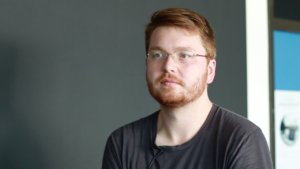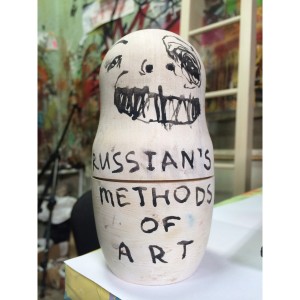So my projects are generally ephemeral. That means they are physically only shortly visible. Then they are translated into stories, be it in photographs or text and remain or nearly gone. I have once made a catalogue with the title: Nearly everything has nearly not happened. And I still find that fitting. It interests me. These possibilities, which shortly scratch the surface of reality and then just remain as a possibility. These locations, the contexts of this performance are often already art, well it’s problematic in public places for example, when the people don’t know what that is. Is it an accident, an advertisement…? There is a lot of friction and also a lot of misunderstandings, which have a certain interesting part but are done with somehow. So, it’s not about the joke and the racket. For me it’s more about this: Now you have told a joke and now…? What is this absurd thing in it? To stay with the project on this edge and that requires, that the contexts are in some way secure enough that this is possible. For example a building site in Zurich at a Saturday evening means, that there are several hundred car drivers who only drive this round because they want action, who open the door and shout: What is this bullocks here? There is a fight for attention. Then there are pedestrians, who don’t see it at all, then there are people, who stand there specifically because they are interested in it. And this coexistence of people should be possible. So, if I make projects in the public space, then I am interested in the pedestrians. But I am also interested in the people who search for it and they all probably have this in common: Ah, it could be different. For example: He is standing lopsided on the facade and I am standing on the ground. Am I also lopsided or what does that actually mean to stand straight on this globe, which is called earth? This is interesting for me. So I request a certain concentration from my ideal audience. The bearing of a question. For me artworks are questions and not answers. I find it important, that the people bear this as well. Just as I bear it too. We bear it together. I request this attendance a bit and this is not always collectible in the public space from all people. This is clear to me. If I am speaking of a building site, of course it’s not a white cube. It’s not a gallery, but it’s really a location of impossibility for art. This is what I find exciting. So I’m interested in this re-locating, so this other location, be it the public space, be it a passage space where the function isn’t enrolled yet. This enables me to lead the observer there, to enable to recognize these conditions of the artwork, which is there to be seen.
Also meine Projekte sind in der Regel ephemer, das heißt physisch sind sie nur kurz sichtbar. Dann sind die übersetzt in Erzählungen, sei es in Fotografie oder Text noch da oder auch schon fast nicht mehr da. Ich habe mal einen Katalog gemacht mit dem Titel: Fast alles ist fast nicht geschehen. Und ich finde das eigentlich noch stimmig. Das interessiert mich. Also diese Möglichkeiten, die mal kurz eine Wirklichkeitsebene schrammen und dann wieder nur Möglichkeit bleiben. Die Orte, also die Kontexte dieser Aufführung sind dann schon oft Kunst, also es ist ja dann im öffentlichen Raum zum Beispiel problematisch, weil die Leute nicht wissen was das ist. Ist das ein Unfall, eine Werbung…? Da gibt es viel Reibung und auch viele Missverständnisse, die einen gewissen interessanten Teil haben aber auf einmal irgendwie gegessen sind. Also es geht mir nicht um den Joke und um das Spektakel. Es geht mir eigentlich mehr darum: Jetzt hast du einen Witz erzählt und jetzt…? Was ist da mit diesem Absurden da drin? Also mit dem Projekt auf dieser Kippe zu bleiben und das bedingt, das die Kontexte auch irgendwo geschützt genug sind, dass das möglich ist. Also zum Beispiel in einer Baustelle in Zürich am Samstag Abend bedeutet, dass man ein paar hundert Autofahrer, die nur diese Runde fahren, weil sie Action wollen, die Tür aufmachen und rufen: Was soll dieser Scheiß hier? Da geht es um einen Kampf der Aufmerksamkeit. Dann gibt es Passanten, die das gar nicht sehen, dann gibt es Leute, die extra hier stehen, weil sie das interessiert. Und dieses Nebeneinander dieser Leute sollte möglich sein. Also wenn ich Projekte im öffentlichen Raum mache, dann interessieren mich natürlich Passanten. Es interessieren mich aber auch Leute, die das aufsuchen und denen gemeinsam ist wahrscheinlich dieses: Ah, es könnte auch anders sein. Zum Beispiel: Der steht jetzt schief an der Fassade und ich stehe am Boden. Bin ich auch schief oder was heißt überhaupt gerade zu stehen auf dieser Kugel, die da Erde heißt? Das interessiert mich. Ich verlange vom Idealpublikum eine gewisse Konzentration. Ein Aushalten einer Frage. Für mich sind Werke ja Fragen und keine Antworten. Ich finde das wichtig, dass die Personen das auch aushalten. Genau wie ich das auch aushalte. Wir halten das gemeinsam aus. Diese Bereitschaft fordere ich ein bisschen und die ist nicht immer und schon gar nicht im öffentlichen Raum von allen Personen einlösbar. Das ist mir klar. Wenn ich jetzt von so einer Baustelle spreche, dann ist das ja nicht ein White Cube. Es ist keine Galerie, sondern es ist ein Ort der Unmöglichkeit eigentlich für Kunst. Das finde ich spannend. Also mich interessiert eigentlich diese Endortung, also dieser andere Ort, sei es nur der öffentliche Ort, seien es Durchgangsräume wo eben nicht eine Funktion schon fest eingeschrieben ist. Das ermöglichst mir den Betrachter dahin zu führen diese Bedingungen dieses Werkes, die da zu sehen sind, mit zu erkennen.

















